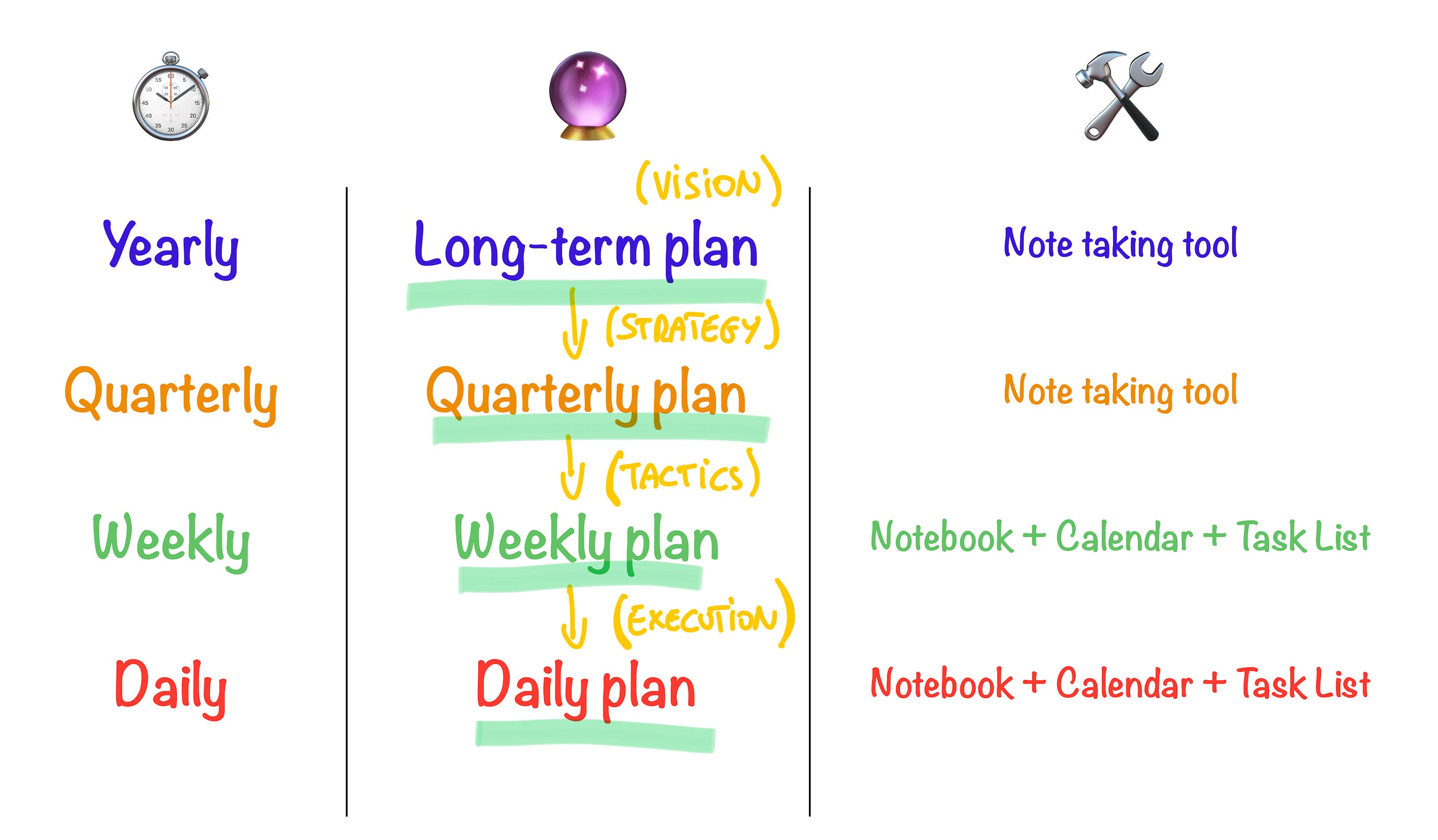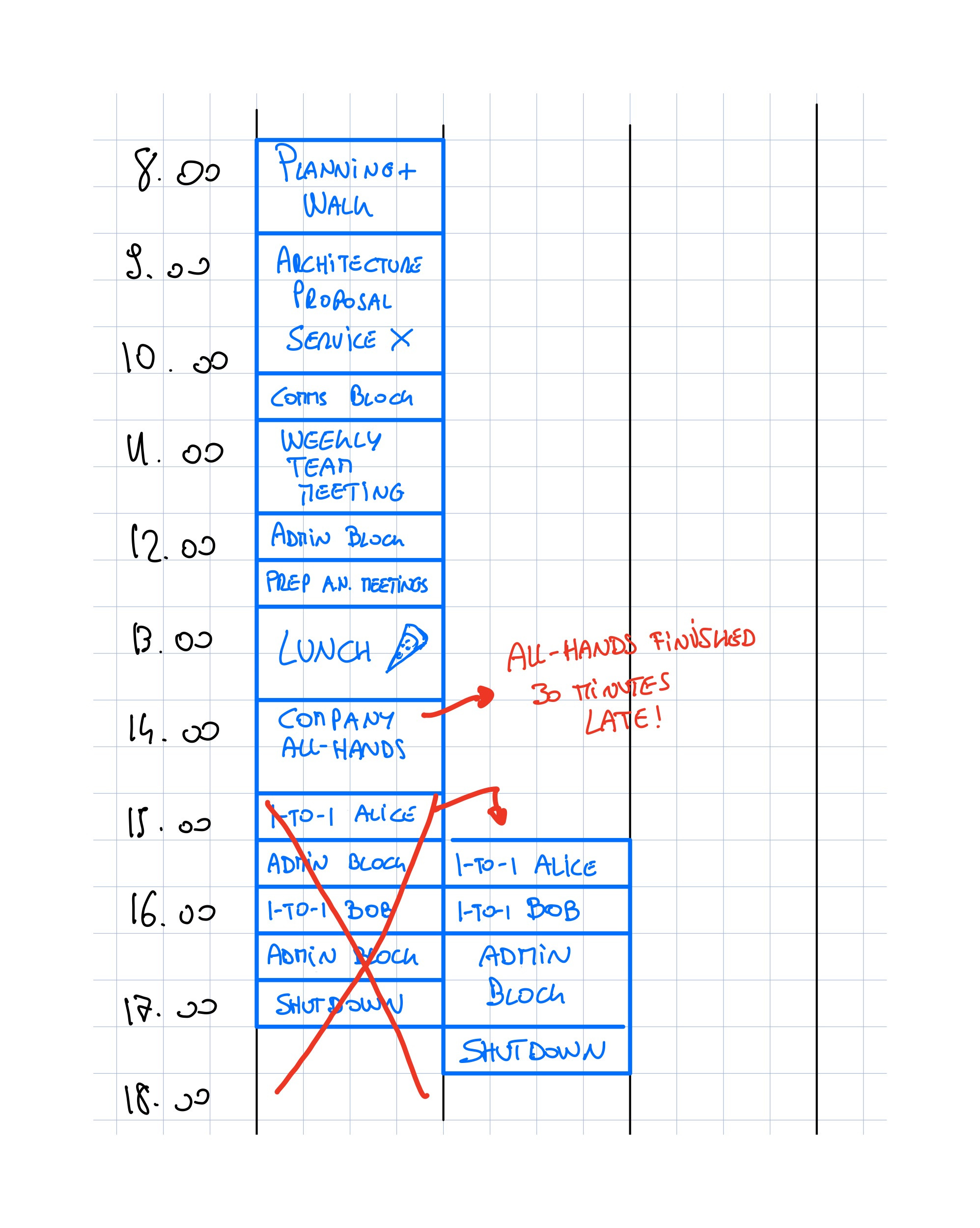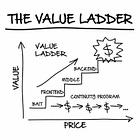Timeless principles of Time Management
- Sergio Visinoni from Sudo Make Me a CTO <makemeacto@substack.com>
- Hidden Recipient <hidden@emailshot.io>
Hi, 👋 Sergio here! Welcome to another free post from the Sudo Make Me a CTO newsletter. If you prefer to read this post online, just click the article title. As this is a free newsletter, I do immensely appreciate likes, shares and comments. That's what helps other readers discover it! Timeless principles of Time ManagementA deep dive on the system I use to manage time and productivity, inspired by many experts in the field.As I prepare a live session on Personal Productivity and Time Management for my community¹, I thought it would be a good idea to write down the key principles and practices I follow in an article to share with all my readers. Personal productivity is a vast topic, and plenty of literature exists on the subject. It would be unrealistic to try to cover all the competing approaches. Instead, I'll focus on the system I use daily and why I find it effective. Before diving into the details, let's start with some fundamental concepts, starting from the evergreen question: Why should I even care about this topic? What is productivity and Why it mattersSome people tend to confuse productivity with busyness or with the sheer amount of output one can generate in a unit of time. I like to think of productivity as maximizing impact over time. I focus on the desired outcome, which can differ significantly across different people. In other words, productivity measures how fast you're moving in the desired direction, not how fast you're moving per se. Being very efficient in dealing with irrelevant tasks doesn't mean being productive. That's often called pseudo-productivity, the performative act of being busy without achieving anything meaningful. Pseudo-productivity is not limited to our professional lives: how much time is spent in mindless activities that don't generate meaningful results for our lives? Doom scrolling, gossiping, reading Elon Musk's and Donald Trump's latest tweets? Our time is limited, and if we leave it to the whims of all the actors surrounding us to decide what we should do with it, we're signing up for a miserable life. Living intentionally separates a well-lived life from just passing through time hoping to win the lottery. This is why I care about personal productivity and constantly try to improve it. That does not mean that I aim to work 16 hours per day, 6 days a week—quite the opposite. One key reason I have systems in place is to avoid that. I want to achieve remarkable results without devoting my entire existence to work. It's less fashionable than going all in founder mode or bragging that you're only sleeping 4 hours per night, but I can guarantee it's possible. If you look beyond the smoke curtains of what's published on social networks, you'll find plenty of examples. Let's first look at three key principles that underline my productivity system. Principle 1: Planning is an actionAnyone who understands at least the fundamental principles of Agile software development should understand why planning matters more than just having a plan. Planning is an action you should practice continuously as a way to bring intentionality in the use you make of your time. Let that sink in for a moment. Many people fall into simplistic thinking about this activity.
That means planning is not something you do once a year and once a quarter, and then you go on with your reactive life. Instead, it's an activity that should be at the core of your productivity systems at different time scales. Planning as an activity is more important than the actual plan. Continuous planning allows you to set a direction and then realize you need to change course because you've hit an obstacle. It also helps you avoid changing course because you've seen something grabbing your attention elsewhere. Principle 2: Planning is worthless if you don't know where you want to goToo many people live in a reactive mode without a clear sense of destination. Sometimes, they have a destination in mind, but it has been imposed on them through social pressure and other forms of extrinsic motivation. Have you ever felt that you're somewhat expected to get promoted to roles with higher prestige and compensation? Do you believe you are expected to follow a career in a particular discipline because that matches your education or family's expectations? Do you think you need to earn more next year than you are now, which will inevitably mean sacrificing personal and family time? If that's the case, ask yourself where those fundamental beliefs come from. Is this the life you want to live, or the life you believe you have to live because <insert external reasons here>? I'm not suggesting you give up everything to become a yoga instructor tomorrow. Instead, I do recommend spending time actively looking for potential sources of inspiration: reading books from people who lived lives that have something that resonated with you, watching documentaries, engaging in different activities, and observing what makes you feel good. The more you do that, the more you'll be able to form your idea of what lifestyle you want to follow, giving you a destination to aim your time and energy toward. Your ideal lifestyle will also evolve over time, and that's totally fine. What I want to do today significantly differs from what I wanted to do in my 20s. It's helpful to think about the life you'd like to live in the next 5-10 years and then review that vision yearly. Once that vision starts to crystallize, you'll better understand what role you want your job to play in it. Maybe you'll discover that you find immense satisfaction in building things and being immersed in a highly entrepreneurial environment, or maybe you'll discover that you find more inspiration in living a quiet life in nature, working part-time and spending the rest of it in activities that help you cultivate deeper life. The only wrong answer here is the one you let someone else answer for you. Principle 3: Context switching is the enemyThere is plenty of literature on this subject, and I'd be baffled if this surprised any of you. We all know that, right? Yet, we constantly create opportunities for context switches to occur regularly throughout our days. I believe FOMO is humanity's second biggest problem, following the climate crisis². We keep notifications active. When notifications aren't, we jump from the activity we're working on to checking our phone, email, or Slack for new incoming sources of novelty. Those feed our dopamine circle, but they deplete our mental energy. We schedule meetings that force us to jump from one topic to another without closure. We don't have explicit WIP limits and work on too many things in parallel. Worse of all, we believe all this is inevitable. We blame the system rather than trying to take action to manage context switches rather than being controlled by them. In addition, we often keep track of all our obligations in our minds, adding to the brain drain. Oliver Burkeman talks about the joy of missing out³, and I believe sustainable productivity can only happen if we embrace it. You can start by taking stock of the major sources of context switches throughout your day and figuring out which ones you can simply ignore because they aren't necessary and don't add any value. OK, enough with the fluffy discussion of vision and principles. Let's get into the specifics of my system. The 4 horizons of planningI use 4 horizons of planning, from a higher level to more specific: #1 Long-Term Goals (Vision)This is where I define the lifestyle I want to live and some major goals I might want to achieve. It usually spans multiple years and is reviewed yearly. I like to review it around my birthday, which happens in November, as it allows me to influence the quarterly plan for the first quarter of the upcoming year. As an example, a dumbed-down version of my current long-term goal is to build a successful solopreneur business that will allow me to work part-time, live close to nature, spend more time with my family and friends, and cultivate interests that make me a better person, such as reading or watching movies. That's because I value flexibility and autonomy, and being successful in this path will ensure both of them will be present at a higher degree compared to where I was one year ago. #2 Quarterly Plans (Strategy)I've been using OKRs for a long time and have found them to be an effective tool. They force you to focus on distilling the few important things you want to move the needle on, identify results that will evaluate the outcomes, and don't require anything complex to implement. A simple Notion page with some formatting is more than enough for what I need. Beyond the OKRs, I also list the most important projects or activities I want to execute or progress on during the quarter. These are supposed to help me achieve the OKRs and are a good way to start off with a realistic plan for getting there. Important: I've been removing specific goals from this list mid-quarter when I realized they were either irrelevant or unrealistic. I am not afraid of sacrificing some of them if that allows me to progress further on a subset of them. #3 Weekly Plans (Tactics)I plan every week on Monday morning or Sunday evening. The plan combines appointments blocked in my calendar, tasks I must complete due to a deadline, and critical goals I want to achieve, such as finishing an article or onboarding a new client. It allows me to look at the reality of my week ahead and ensure I prioritize the available time accordingly to my goals. #4 Daily Plans (Execution)Every day is planned using time-block planning. Every chunk of time during my work day is assigned to a particular activity. The plan combines what is already on my calendar with all the remaining time slots I want to dedicate to making progress on something that matters. The 4 components of my productivity systemThere are four critical components in my productivity system, and none of them is rocket science.
How they work together in practiceStephen Covey made the expression “Start with the end in mind” famous, emphasizing how important it is to begin this journey with your goal. Likewise, the foundation for my productivity system is not in the tools but in the destination. The destination is set in the Long-Term plan, aka my vision. That helps me guide the definition of my quarterly goals. Toward the end of each quarter, I invest some time looking back at the progress so far and come up with a list of goals for the upcoming period. I try to stick to the simple 3x3 rule here: maximum three objectives, maximum three key results in each. This forces me to focus on the essentials. Every week, I review the previous week to get a sense of how it went: Did I have to adjust my plan often? Did I meet most of my goals? I also review my task list to ensure it's up-to-date and clean. If you're familiar with the weekly review from the GTD framework⁴, that's more or less what I do. By doing this, I surface the tasks that need to be done in the upcoming week and assign them specific deadlines. I use Notion Calendar to visualize all my calendars in one place, adding extra convenience. In the same view, I can show the scheduled tasks on the day they're supposed to be completed. I then look at my quarterly plan and calendar for the week ahead, define the goals for the week, and on which days I intend to work on the most critical projects. I have some tasks scheduled in auto-pilot, such as writing newsletter articles every Tuesday morning, which reduces the number of decisions needed at this stage. I time-block the day ahead every morning based on my weekly plan and the time available—i.e., unscheduled—on my calendar. Whenever something happens on that day that forces me to drift from the plan, I take a few minutes to cross off the remainder of the day and come up with a revised plan in the adjacent column. During each time block, I stick with the task or activity I had planned in advance, protecting me from context switches and distractions. I have some special blocks I use throughout the day, such as Admin Blocks and Comms Blocks. Admin blocks are where I go through my daily task list and execute a batch of tasks roughly fitting a 30-minute or 1-hour block. Comms blocks are blocks that I use to check email inboxes, Slack messages, and other sources of communication with other people. I either reply on the fly or capture the relevant actions in my task list to be processed later. And that's it; there is nothing more complicated than that. From there on, rinse and repeat. I am deliberately leaving out plenty of details here so as not to overwhelm you, but feel free to use the comments section to ask for more specific information about how I use certain system components. Key Benefits of taking this approachBased on my experience, there are a few significant benefits to following this approach:
These benefits compound over time as you can progressively invest more energy in creating more clarity for yourself as you improve. If you're starting from scratch, you might be tempted to start by defining your long-term vision, as I mentioned in the article. The problem with that approach is that you will likely lack the clarity and mental energy to have a meaningful conversation with yourself at that level. My recommended starting point, which David Allen also recommends in his GTD book⁵, is to start at the tactical and execution levels. That's why I want to leave you with a challenge. During the remainder of this week and all of next week, do the following:
When you see the early benefits after the first week, I recommend you start thinking about how you could set goals for the upcoming quarter, Q4 of 2024, which is less than one month away. When you feel ready, lift your horizon up one level and write down your long-term plan and vision. I'll be delighted to hear about your wins and learnings as you go through this process.⁶ Recommended ReadingsThough the system I use is customized according to my needs and preferences, I have been learning from the real experts in this field. If you want to go deeper, here are some books I recommend you read and internalize. Some might require multiple reads before you really grasp the key principles and practices. They have all been fundamental, one way or another, for my journey up until now. As usual, these are all affiliate links.
If you think other books should be on this list, please share them with us in the comment section. I'm always interested in getting more perspective. If you found this valuableIf you found this valuable, here are other ways I can help you and your company:
1 If you want to know more about the community, check out this post, and feel free to reach out if you are interested in joining. Right now, there is only one seat left in the Founders plan! 2 In case you're wondering, the third is egocentric billionaires who have lost contact with reality and believe they are the new messiah on a mission to save the world. 3 See the Recommended Readings section at the end of the article. 4 See the Recommended Readings section at the end of the article. (I can't link the same footnote twice, apparently) 5 By now, you should know what this note is supposed to say. Hint: 👆 6 For the interested reader: I wrote this article in a 3-hour time block on Tuesday Morning. During this time, I was entirely focused on this article and didn't check my phone, email, or any other sources of distraction. I took a break in the middle, which helped me move around a bit. During the break, I handled some household chores that required my hands but left my brain relaxing. I deliberately avoided checking my phone for quick dopamine fixes. I'll still need a one-hour block this afternoon to finish editing, adding illustrations, and schedule it for publishing. If I didn't follow the discipline of time-blocking, it would easily take twice as much, and the quality might even be worse. Sudo Make Me a CTO is a free newsletter edited by Sergio Visinoni. If you found this post insightful, please share it with your network using the link below. If you or your company need help with one of the topics I talk about in my newsletter, feel free to visit my website where you can schedule a free 30 minutes discovery call. I'd be delighted to investigate opportunities for collaboration! |
Similar newsletters
There are other similar shared emails that you might be interested in:


